The Plextor M6V (256GB) SSD Review
by Billy Tallis on October 12, 2015 8:00 AM ESTRandom Read Performance
Our random read performance test is conducted on a full drive and tests queue depths from 1 to 32. We focus primarily on the lower queue depths that are typical of interactive use, but also look at how the performance and power scales to more intensive loads. For desktop use, searching and virus scanning are typically the biggest sources of random reads, and they can exercise some of the larger queue depths.
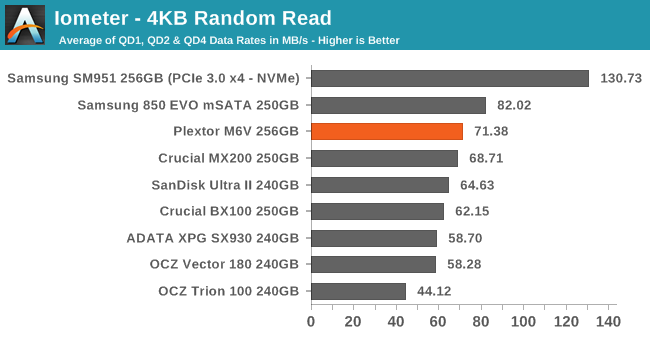
The M6V posts above average performance on the random read test, and is clearly better tuned for it than the Crucial BX100.
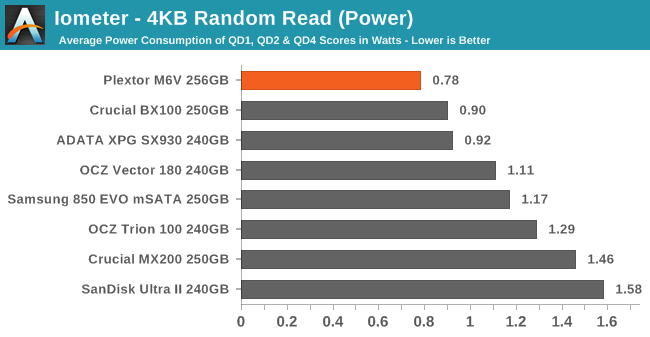
The power consumption and thus efficiency here are significantly better than the competition.
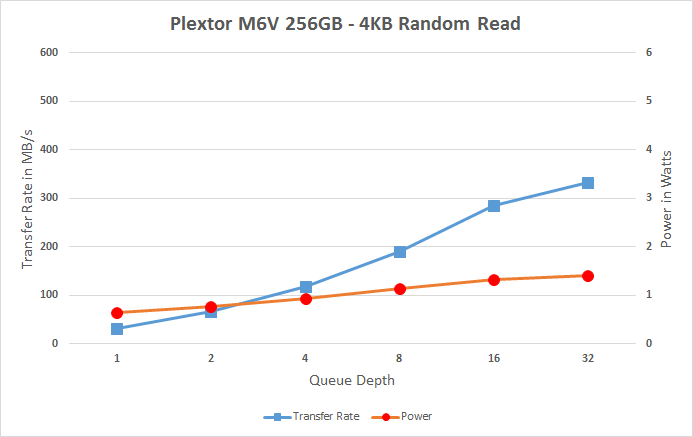 |
|||||||||
| Default | |||||||||
The M6V scales well with increasing queue depths, and its high rating above comes mostly from its good performance with queue depths of 2 and 4. Power consumption starts low and only grows slightly.
Random Write Performance
The random write test is confined to a 16GB portion of the drive, which is otherwise empty. This allows the drive to demonstrate much higher performance than on our performance consistency test that fills the drive. Tasks like installing software updates can modify a lot of files, but aren't hitting the entire disk. Random writes to the entire disk are usually found only in enterprise workloads such as large databases.
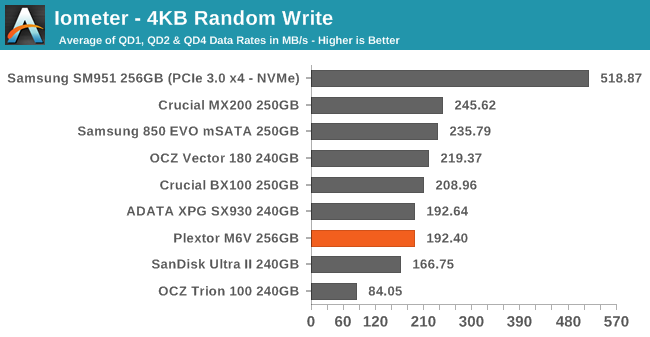
The M6V falls back to being one of the slowest MLC drives, but the spread among 240-256GB drives isn't huge.
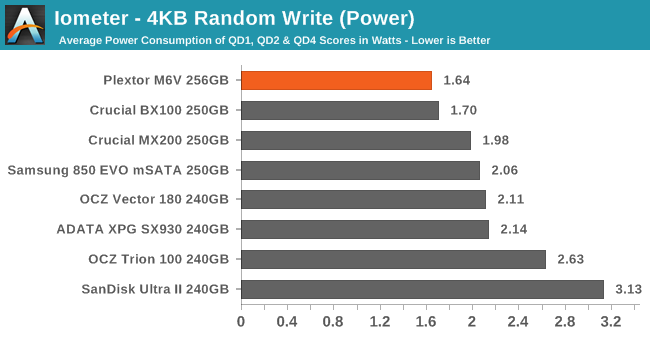
The lower performance again brings power savings, showing that the M6V is pretty well optimized, just not for peak performance.
 |
|||||||||
| Default | |||||||||
Many drives of this size hit a performance limit somewhere along this test, but the M6V scales smoothly across the range of queue depths. However, the overall increase is small and the lower queue depths are left lacking.










51 Comments
View All Comments
Vepsa - Monday, October 12, 2015 - link
Because not everyone needs or can afford a PCIe SSD. Or they have a computer that can't boot from one. I'd love two 250GB SSDs for my home server, but they have to be SATA or SAS because all its PCIe slots are full.Mr Perfect - Monday, October 12, 2015 - link
Yes, SATA it's still quite relevant. It's not exciting, but we can all use them.hyno111 - Monday, October 12, 2015 - link
There are currently no consumer PCIe SSD for laptops. SM951s are for OEM and may have trouble finding warranty. 950 pro is not out yet.Not to mention prices..
close - Monday, October 12, 2015 - link
So it's integrated GPU if you want power savings and Titan X SLI if you want performance. Nothing in between?There are shades of gray (maybe less than 50 are distinguishable though). Where do I fit a PCIe SSD? Unless it's a PCIe card then it's out. Also the price is a downer as while it may bring huge performance benefits, they don't justify the price for most users.
And don't forget that *any* computer out there will hugely benefit from even a cheap SSD while upgrading from that cheap SSD to an expensive one upgrading will bring less impressive improvements.
xenol - Monday, October 12, 2015 - link
The practical performance for many operations on secondary memory do not make anything beyond a SATA based SSD worthwhile. Go look up anecdotal reviews of RAM Drives, and you'll find many operations, despite RAM Drives offering orders of magnitude better performance, offer at best 10% better performance. Is it worth spending nearly twice as much on a PCIe drive than it is to get an SSD with double the capacity for what amounts to a 10% performance increase? No.Also, most storage operations that happen during regular use of a PC are very tiny. Most of them are <128KB in size. At that point, bandwidth is insignificant, but latency is what matters. And that's where SSDs really shine over HDDs.
Impulses - Monday, October 12, 2015 - link
It's all relative, there's plenty of common content creation scenarios where a PCI-E SSD makes a big big difference... Whether it's worth it or not is pretty subjective.Enthusiasts used to pay for stuff lime Raptor where the difference was relatively minor by comparison... Small (256GB) SM951 for me right now for the OS/apps, 2x1TB 850 EVOs for most else, why make it either/or? (on a desktop anyway)
xenol - Monday, October 12, 2015 - link
If you're on an unlimited budget, then sure, go spend money on the bestest thing possible.But if you're on a limited budget, sacrificing a few things here and there because they don't add much to the pie are the decisions you have to make. If you're a gamer, PCIe SSDs are worthless. Go spend the difference on a better video card. If you're a content creator, it still depends on the content being created. The only time I can ever see a high speed SSD as necessary is if you're dumping a ton of data from somewhere. Otherwise, just throw more RAM at the problem. Besides that, the CPU is probably still the biggest bottleneck in those scenarios (a year or two ago, someone mentioned that Intel's Ivy Bridge E was the only part he could find that could do a 1:1 BD-ROM rip and encode, which means for a 2 hour video and assuming the entire 25GB was used, the CPU was pumping out ~120MB/s... You can easily sustain that on a hard drive)
StrangerGuy - Tuesday, October 13, 2015 - link
Define "enthusiasts". Long ago during Raptor days there were also a huge mass of so-called "enthusiasts" who recommended against Raptors because they were a big stinking waste of money compared to regular 7200 rpm drives. Enthusiasts aren't people who will mindlessly throw good money for some ultra niche hardware they don't need despite what you want us believe.name99 - Monday, October 12, 2015 - link
Oh don't be narrow-minded.In just the last month I have
(a) replaced the HD in a friend's old MacBook Pro with an SSD (to speed up the machine)
(b) had the HD in my 3-yr old iMac fail (not exactly fail, but enough SMART warnings that it's time to stop gambling on it staying alive), so I switched to booting off a 1TB SSD stuck in a USB-3 enclosure.
Both of these were perfect use cases for a SATA SSD...
Coup27 - Monday, October 12, 2015 - link
What on earth are you smoking? (dj_aris)